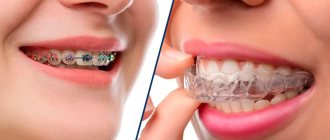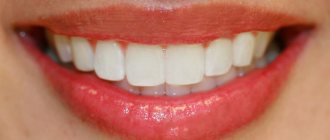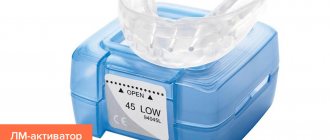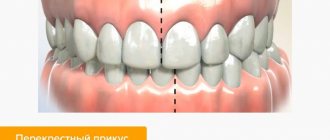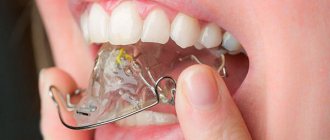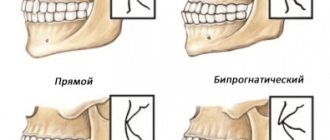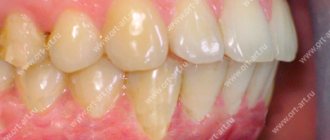Bite defects are not as rare a problem as it might seem. Medical statistics show that every third person has malocclusion in one form or another! If the anomaly is serious and noticeable, it is corrected in adolescence, but people are in no hurry to deal with mild crooked teeth. And most often because they don’t want to wear braces that others can easily see.
But modern dentistry is ready to offer patients an alternative to braces - these are transparent aligners, wearing which can help correct the bite and acquire a beautiful smile. At the same time, your treatment will remain invisible to strangers and will not cause you any discomfort!
In the article we will talk in detail about how bite defects are treated with mouth guards, what are its features, what types of mouth guards exist and how long they will have to be worn in order to straighten the teeth and acquire an attractive smile.
What are orthodontic aligners, indications for use
The aligners also have a second name - aligners. At their core, they are soft and transparent overlays for teeth, which are made from hypoallergenic polymer materials. Mouthguards, unlike braces, are removable structures: you can put them on and take them off yourself, without visiting the orthodontist’s office.
The mechanism of the beneficial action of mouth guards for correcting occlusion is as follows: the design completely covers the jaw arch and creates pressure on the areas of the dentition that need correction. The main advantage of orthodontic aligners is convenience. Wearing them does not cause any discomfort, adaptation to them is quick, and when correcting a bite with mouth guards, there is no need to follow a diet that excludes any food products.
When can mouth guards be used to correct a bite? Indications for the use of orthodontic aligners are as follows:
- The presence of noticeable interdental spaces;
- Slight displacement of individual teeth in a row;
- Slight crowding of teeth;
- Poor open, cross or distal bite.
IMPORTANT: Unfortunately, serious malocclusion cannot be corrected with mouthguards. To correct significant pathologies, braces are used, most often metal ones, which can create strong pressure on the teeth and thereby bring them into the correct position.
Take a short test and calculate the cost of treatment!
Take a short test
- Jaw selection
- Availability of photo
- Selecting a brace system
- Date of treatment
- Cost calculation
×
Manukyan Artavazd Genrikovich
Chief physician of the clinic
Indications and contraindications
Typically, a mouthguard for straightening teeth in children does not cause irritation and is not felt in the mouth. The transparent and flexible design fits tightly to the teeth, making it invisible to the eye. We have already named the main indications for use - they include dental pathologies of growth and its direction.
And although the doctor will warn you about possible obstacles, we will give you a list of contraindications.
Mouth guards for children are a modern, safe and effective method of treating children's malocclusion.
How is a bite corrected using mouthguards?
Correcting a bite with mouth guards begins with a visit to the orthodontist's office. During the first appointment, the doctor examines the oral cavity, assesses the correctness of the bite, and additional diagnostic measures may be prescribed - for example, a panoramic photograph of the jaw. A detailed diagnosis before starting orthodontic treatment and bite correction will help the orthodontist choose the most effective correction method for a specific clinical case.
If the diagnosis shows that in your case it is possible to correct the bite with mouthguards, then further treatment will proceed according to the following scheme:
1. Professional oral hygiene will be carried out, necessary for high-quality cleaning of teeth from plaque and tartar.
2. Impressions are taken of the teeth, on the basis of which a plaster model of the patient’s jaws is made.
3. Mouthguards are created using the finished plaster model. Aligners are made not as a single copy, but as a whole set. You will change mouthguards to correct your bite according to the scheme that the orthodontist will develop for you. Changing the aligners is required to create the correct pressure on the teeth, which will promote their displacement and alignment.
IMPORTANT: The effectiveness of correcting your bite with mouthguards will largely depend on your attitude towards treatment. Mouthguards must be worn for at least 20-22 hours. If you break this rule, you may not expect a positive result from bite correction!
The process of making custom trays
The production of individual orthodontic aligners takes place in several stages. First, the doctor takes an impression of the patient's teeth and sends it to a dental laboratory. There, a specialist makes a working form, scans it and creates a three-dimensional computer model.
At the next stage, the doctor draws up an individual treatment plan and calculates how many trays the patient will need. After which the manufacturer produces the required quantity.
Once all the structures are ready, the orthodontist hands them to the patient and explains how to use them and gives recommendations for care.
How many trays may be needed to correct a bite?
How many trays are included in the bite correction kit? The answer to this question will depend on two main factors:
- Difficulties in malocclusion that needs to be corrected;
- Patient's age. The older a person is, the longer orthodontic treatment can be, because after the final formation of the dental system, tooth displacement occurs more slowly. That’s why dentists recommend correcting your bite in childhood and adolescence!
Thus, a full course may require about 15-40 pairs of mouth guards, and each mouth guard will have its own shape and size. To correct the bite, the mouthguards are changed every 2-3 weeks.
Regular change of aligners when correcting a bite is necessary: it allows you to achieve the tightest possible fit of the structure to the teeth. Due to the high density of the mouth guards, they will exert pressure on the teeth, which will cause the teeth to shift in the desired direction. As soon as the pressure becomes insignificant, the used mouth guards are replaced with a new pair.
Peculiarities
The main purpose of an orthodontic mouthguard is to correct dental growth disorders in children. But wearing aligners is a mandatory step even after removing braces to fix the achieved result.
Thermoplastic aligners are a ready-made material that simply takes the desired shape under the influence of temperatures. Individual mouthguards are made in a special laboratory.
Wearing aligners has its own characteristics. Over the entire period of treatment, the patient will need to change a large number of aligners, which will correspond to the changes occurring in the teeth.
Wearing orthodontic products does not cause discomfort in patients. They get used to them in 3–4 days. You can install and remove aligners yourself, and they are also easy to clean.
Types of mouthguards for correcting bite
Orthodontic mouthguards for correcting bites have their own classification. They are divided into different types according to the following characteristics:
— Material of production. Mouthguards for correcting bites can be made of silicone or polyester;
- Production technology. On this basis, standard and individual dental guards are distinguished.
Each type of mouthguard for correcting the bite has its own characteristics, which will be useful for people planning to undergo orthodontic treatment.
Treatment of bruxism with mouth guards
Bruxism is involuntary grinding of teeth. Its consequences for the patient's jaw are very serious. This is not only the rapid wear of dental crowns. It is much worse when inflammation develops due to bruxism, followed by deformation of the jaw joint. In this case, the patient often begins to experience headaches.
Special mouthguards will help correct the situation. They do not allow the jaws to close completely, due to which the tension in the muscles gradually disappears and they relax. To achieve a stable result, you need to wear them at least 10 hours a day. There are two types of mouth guards for bruxism:
· Daytime. They are used if the patient suffers from daytime teeth grinding. Such structures are transparent. They are made individually. They do not cause discomfort, but daily mouth guards should be worn constantly.
· Night. They are worn when teeth grinding at night. Use only at night.
Customized dental guards
This is the best option for correcting malocclusion, because such mouthguards are made individually for each patient and based on impressions of his teeth. This allows you to ensure maximum tightness of fit of the trays to the teeth.
Individual mouth guards for correcting occlusion are made from silicone - a plastic, hypoallergenic and transparent material, so the designs will be comfortable to wear and completely invisible on dental surfaces. One of the most popular options for customized mouth guards for correcting malocclusion is the Invisalign system. But they are not made from silicone, but from a biopolymer and sufficiently rigid material. We will talk in detail about Invisalign mouth guards for correcting bites in a separate section of our article.
What methods exist for straightening teeth and correcting bites in children?
The first method of straightening teeth in children is the “classic of the genre”, something that was known back in the Soviet Union - these are plates.
What are the advantages of records (there are four of them):
- is that records are relatively cheap to make,
- the fact that children can easily brush their teeth (again, due to the fact that they are removable).
- the third advantage is that there are quite powerful mechanics for correcting the bite, because most often special screws are installed in the plates, which are unscrewed by the parents, that is, which are activated and create the force necessary either to move the teeth or to expand the size of the jaws.
- well, and another fourth plus is that they are produced quite quickly, that is, you don’t have to wait long for them - literally a few days, and the record is ready.
What are the disadvantages of records? There are also four of them:
- The first disadvantage of the plates
is that the plates are quite uncomfortable. The plate is quite bulky - accordingly, the space for the tongue is reduced. It is constantly observed that children play with records: they remove them with their tongues, play around, and so on. Therefore, they are quite inconvenient. - Second minus .
Serious. The records change the perception of taste. This is especially true for the plate on the upper jaw. The fact is that there are taste buds on the hard palate, the plate covers them, and the child, in theory, when undergoing a course of bite correction should walk with the plate constantly, removing it only to brush his teeth. It turns out that when a child eats, the food does not touch the palate, and therefore the sensation of taste changes. It's not very pleasant. - The next, third disadvantage
(I have already partially mentioned this) is that diction is impaired with records due to the fact that they are simply in the space for the tongue. Children adapt quite quickly to records in terms of diction, but still there are definitely residual phenomena, and if, say, we have a schoolchild in front of us, then this creates a lot of inconvenience, for example, from the point of view of sound pronunciation in foreign languages - where teachers are constantly fighting for pure sound pronunciation, for correct diction, and so on. In this regard, the plates are, of course, very inconvenient, and the temptation to take them off during classes and then forget to put them on is very great. - The fourth minus
. And this is also the next minus for parents and doctors, and a plus for children (this is such a plus or minus) - the ability to remove these plates! Yes, this is convenient for hygiene, but from another point of view, children are often guilty of this - when they leave parental control (for example, to school), they take off the records and put them, God willing, in some other box ( or even in your pocket), they walk around all day without the records, everything is fine, and then they put them on again in front of their parents. It turns out that the effectiveness of treatment in correcting a child’s bite in this case is reduced to zero.
Summary of records
So what can I say based on the records? If the child is disciplined, if he wears the plate well, constantly and follows all the doctor’s recommendations, then this is a very good technology, and it can solve certain problems quite quickly. The downside - from all that I have listed - is that if the child is undisciplined or, say, there is low cooperation with him, then in this case the plates are more of a torment than any kind of effectiveness.
Questions and answers about records
- But there is also a moment that even if the child does not wear it partially, it is twisted, expanded, and the parent can notice that it does not go over the teeth if you start to expand it.
- Absolutely right.
- Then see a doctor.
It turns out that there is still some impact on the child in this situation. - No. You see, the fact is that if the child does not wear the plate, then the jaw does not expand properly, as intended in the plate. That is, in this case the plate dangles, as patients sometimes say, it’s like a galosh. It no longer puts pressure on the teeth and does not fit. And in this case, of course, the doctor, for his part, tries to somehow correct it, screw it back, but often this leads to the fact that the plate has to be redone. And these are new investments, we are stalling in one place, and the problem is not being solved. Therefore, the effectiveness of the plate, if you wear it, is high, but, unfortunately, there are a lot of such “victims” who did not wear the plate, and then they come at an older age.
Invisalign aligners for correcting malocclusion
Invisalign aligners are a set of designs, the number of which is determined for each patient individually. The more complex the bite defect that needs to be corrected, the more number of trays will be made for a full course of correction. Unlike other types of aligners, Invisalign aligners can also be used to correct complex malocclusions, such as straight and medial bites.
Invisalign aligners are made to correct the bite using a 3D model of the jaws, which is created by a computer program. The use of computer technology allows not only to obtain anatomically accurate orthodontic structures for effective treatment, but also to show the patient the final result of the correction.
The three-dimensional model and impressions are sent to a laboratory in the USA, where a full set of mouth guards is manufactured to correct the bite. When the kit is ready, the patient is invited to the clinic, where the orthodontist gives detailed advice on wearing the aligners and caring for them.
Invisalign mouth guards are one of the most expensive types of aligners; the total cost of a course of treatment starts at 400,000 rubles. However, these are the most convenient and effective mouth guards to use and, importantly, are invisible on dental surfaces. This quality of Invisalign aligners is especially appreciated by adult patients.
You can get detailed advice on Invisalign aligners and their use in bite correction at our premium dentistry clinic in Moscow - “Aesthetica”. Making an appointment with our dental specialists is very simple: you can do this through a special form on the website or by dialing our contact phone number. "Aesthetica" - advanced technologies for the health of your teeth and the beauty of your smile!
Does a mouthguard help straighten teeth?
The principle of operation of aligners is almost the same as that of braces - moving teeth into the correct position by applying pressure to them, but the impact of aligners is much gentler. An additional advantage is that this orthodontic design does not require correction; alignment occurs by changing sets.
In general, the effectiveness of aligners directly depends on production technology and a correctly drawn up treatment plan. Some manufacturers openly declare that their product can completely replace braces. Other brands correct both complex and simple dental anomalies, but indicate certain restrictions on indications. These details are always listed on the company’s website and, as a rule, are known to orthodontists.
However, there is one significant caveat. Even if you choose a reliable manufacturer and find a good specialist, the procedure will not give the expected result if you wear the product less than 20 hours a day and do not follow the doctor’s recommendations.
Advantages and disadvantages of using mouth guards to correct bites
Mouthguards for correcting bites have a number of advantages that make orthodontic treatment comfortable and convenient for patients:
— Mouthguards are removable structures, and this provides a number of advantages. Firstly, the mouth guard can be easily removed before an important meeting or special event, and secondly, this allows for high-quality oral hygiene and comfortable eating. You simply remove the mouth guard while eating for quality cleansing;
— The process of adaptation to mouth guards for correcting malocclusion proceeds quite quickly. In just 2-3 days you will stop noticing the aligners on your teeth;
— Wearing aligners does not cause problems with diction and does not interfere with active communication;
— The elastic material of the mouth guard does not injure the soft tissues of the oral cavity, does not cause allergic reactions and does not have a negative effect on tooth enamel;
— Mouthguards for correcting bites are made from transparent materials and therefore they are invisible on the teeth;
— The structures are easily cleaned from food debris and plaque;
— Correcting your bite with mouth guards can be combined with teeth whitening: to do this, just apply a special whitening gel to the inner surface of the product.
Treatment of bite defects with mouthguards is possible at any age and has fewer indications than therapy using traditional braces. But in addition to the advantages, mouth guards for correcting bites also have some disadvantages that are important to consider before starting treatment.
Among them:
— Mouthguards cannot correct serious malocclusions;
— It will take a long time to produce a full set of mouth guards to correct your bite.
It is worth noting that the price of correcting a bite with aligners may be more expensive than treatment with braces.
The most popular mouthguard manufacturers
The most popular products on the market are from several companies:
- American plastic mouthguards. Quite affordable, they give noticeable and quick results.
- 3D Smail. Manufactured in Russia. There are many models that are suitable for the most complex defects. If there are contraindications to the use of braces, this option may be the last chance. Orthodontists prescribe them only after reaching 14 years of age.
- Star Smile. Another reputable domestic brand. Can be used when the child is already 6 years old.
- Invisalign Teen. Quite expensive American models. Suitable for difficult cases, easy to use.
- Clear Corret. The mouth guard shows an excellent level of adjustment. They do not cause allergies and feel comfortable in the mouth.
Rules for wearing and caring for mouth guards to correct your bite
There is nothing complicated about caring for mouth guards to correct your bite. All you need to do is:
1. Remove the mouth guards from your mouth while eating and each time after removal, rinse them in clean, cool water. 2. After removing the aligners and before putting the aligners back on, carefully and efficiently brush your teeth to remove plaque and food debris. In this procedure, it is recommended to use not only a brush and toothpaste, but also dental floss and rinses. 3. The outer surface of the trays to correct the bite should be cleaned with a soft brush and paste. 4. Aligners should be stored in a special container. 5. If you accidentally damage the mouthguard, it should be replaced with a new pair. 6. Mouthguards cannot be bent, washed with aggressive substances or just hot water.
And of course, don’t forget that mouth guards only work to correct your bite if you wear them regularly and at least 20 hours a day.
How long does aligner treatment last?
How long you need to wear the aligners depends on the amount of tooth movement required. The aligners can show the first visible results after just a day of wearing. It is strongly not recommended to remove the aligners, because the position of the displaced teeth has not yet been fixed, and the chance of returning to their original place is too great.
To achieve good treatment results, it is recommended to wear the aligners for about 22 hours a day and remove them only to brush your teeth, eat food and drink colored drinks. And yet, what is the treatment period for bite correction with aligners?
Dental studies confirm that it takes at least 14 days for teeth to be fixed in the bone in their new position. One set of aligners is designed to move teeth up to 0.33 mm, after which the stage of wearing subsequent aligners follows. On average, treatment with an aligner lasts about 13 months, after which there is a transition to wearing retainers only at night. These devices will allow you to consolidate the results obtained and give your teeth more time to settle in a new place forever.
Your orthodontist will discuss with you in detail the individual duration of treatment and the possibility of taking a break from it.
How often should aligners be changed?
Typically, custom aligners are worn for two weeks. Wearing time may vary in individual cases, depending on your treatment goals and your body's response to the aligners. It is impossible to say how many aligners are needed to correct teeth in your case without assessing the clinical situation.
How are aligners different from braces?
Aligners are called an aesthetic alternative to fixed braces because they are completely clear and can be removed if desired. The main difference between braces and mouthguards is that the teeth are displaced due to the force of tension (the teeth are pulled by ligatures to the curved arch of the brace system). Aligners are a ready-made form of a dental arch, which carefully sets the direction for correcting the bite.
The principle of operation of the aligners ensures gentle movement of teeth without pain and additional stress on the gums. As soon as the teeth are in the position programmed by the aligner - but only after 2 weeks - it is replaced by a new one, which further corrects the dental arch. One mouthguard replaces another - and so on until you are satisfied with your smile!
Proper care of your aligners
You wear your aligners day and night. In this way, optimal bite correction is possible. During meals and during daily brushing of your teeth, you can remove the splints and then reapply them without any problems. As a result, they provide greater comfort in everyday life than fixed braces that remain in the mouth while eating.
You need to remove the aligners carefully, trying not to bend them. Do not confuse upper aligners with lower aligners. Keep your aligners in a clean container while you eat or brush your teeth.
How to properly clean your aligners?
Like teeth, mouthguards also need regular and thorough cleaning:
- To clean the aligners from food debris, plaque and bacteria, use a soft toothbrush and toothpaste.
- Do not use mouthwash or denture cleaners - they are harsh on the plastic and can damage the aligners.
- After brushing with toothpaste, rinse your aligners thoroughly with warm water. It should not be hot, otherwise the plastic will deform.
- Use special braces cleaners once a week. They clean the aligners more thoroughly and also remove stubborn stains.
Oral hygiene when correcting malocclusion with aligners
In addition to cleaning your aligners, be sure to maintain optimal oral hygiene to prevent dental and periodontal disease:
- The mouth guards can be left on the teeth while drinking water. For all other drinks (especially hot ones), they must be removed.
- Aligners must be removed before eating.
- Before placing aligners on your teeth, clean them thoroughly. Use interdental brushes and dental floss to remove food debris from between teeth.
- If you can’t brush your teeth after eating, be sure to rinse your mouth. Then brush your teeth as soon as possible.
- Before reinserting your aligners, rinse them under warm running water.
Duration and effectiveness of treatment with mouthguards for correcting malocclusion
The timing of treatment will depend primarily on the complexity of the malocclusion that needs to be corrected. The average duration of aligner therapy in adult patients is 1 year. This is taking into account your disciplined approach to treatment! The orthodontist will definitely calculate the approximate time frame for the general course of correction when drawing up a treatment plan!
Mouthguards for correcting bites are effective in correcting mild anomalies; if you need to eliminate severe crowding of teeth or serious pathology, it is optimal to plan treatment using classic braces.
Teeth straightening with aligners: pros and cons
Using an orthodontic mouthguard to correct the bite and position of teeth has advantages in terms of comfort and aesthetics:
- Transparency and invisibility.
- Does not irritate mucous membranes with metal parts and ligatures.
- Less painful tooth displacement than when wearing braces.
- The aligners are very comfortable to wear.
- Ease of oral hygiene and structure care.
- High individuality of the treatment course.
- There are few restrictions regarding food intake and hygiene procedures: the aligners can be removed at any time.
- Treatment with aligners can be completed ahead of schedule if you have already achieved a result that you are satisfied with.
- Correcting your bite with aligners affects not only the health and beauty of your bite. The devices help eliminate muscle tension, joint dysfunction, bruxism, and headaches. An incorrect bite causes tension that spreads to the neck, head and back. By correcting your bite with aligners, you can relieve this tension and reduce pain.
Despite the many benefits, you should also be aware of the disadvantages of aligners, such as:
- Impaired diction at the beginning of treatment - disappears after adaptation to mouthguards;
- Sometimes irritation of the mucous membrane of the tongue and cheeks occurs (caused by unusual constant contact with the aligner);
- A feeling of pressure on the teeth, which indicates their movement;
- A high level of self-discipline is required for a conscious approach to treatment, since aligners should only be removed for eating and hygiene.
Bite correction with aligners is a reasonable alternative to braces in orthodontic treatment for adults. The device is practically invisible in everyday life and is easy to maintain and use.
Price for mouthguards to correct bite
The total cost of a course of bite correction with aligners will depend on the length of treatment and the number of aligners that will need to be made. In addition to the price of the aligners themselves, it is worth considering additional procedures that may need to be performed before starting orthodontic treatment. Thus, mouthguards should not be worn if you have caries, gum disease, or poor oral hygiene. Diagnostics, photographs and casts of the jaw are paid separately. Therefore, the exact cost of a course of treatment with mouth guards to correct your bite can only be calculated for you in the orthodontist’s office.
If you are thinking about correcting your bite, come to our clinic in Moscow - “Aesthetica”! Our experienced orthodontists will definitely select the treatment method that will be most effective in your case! We offer our patients the best technologies, materials, individual approach and guarantee that with us you can treat your teeth and get a beautiful smile in a comfortable environment and without pain!
Classification
To correct the bite, stabilizing mouth guards are used, which are made from biomaterials.
Orthodontic structures differ in their production method: thermoplastic and individual. The cost of correcting a bite with mouthguards is higher if it is a custom-made product. However, this design is much more efficient and convenient.
A significant difference in the price of bite correction with mouth guards is noted depending on the characteristics of their use. For moderate and complex defects, 24-hour products are used, which also require periodic replacement. Over the entire period of treatment, up to 50 pieces may be required. While night guards are replaced only 2-3 times.
The choice of aligner model depends on the indications, the orthodontist’s recommendation and the patient’s choice. For certain indications, a specialist may recommend wearing braces; however, after they are removed, the patient still receives aligners to fix the result.
